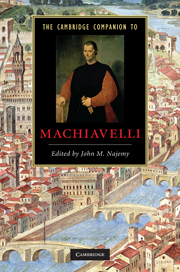Book contents
- Frontmatter
- Introduction
- 1 Niccolò Machiavelli: a portrait
- 2 Machiavelli in the chancery
- 3 Machiavelli, Piero Soderini, and the republic of 1494-1512
- 4 Machiavelli and the Medici
- 5 Machiavelli’s Prince in the epic tradition
- 6 Society, class, and state in Machiavelli’s Discourses on Livy
- 7 Machiavelli’s military project and the Art of War
- 8 Machiavelli’s Florentine Histories
- 9 Machiavelli and Rome: the republic as ideal and as history
- 10 Philosophy and religion in Machiavelli
- 11 Rhetoric and ethics in Machiavelli
- 12 Machiavelli and poetry
- 13 Comedian, tragedian: Machiavelli and traditions of Renaissance theater
- 14 Machiavelli and gender
- 15 Machiavelli’s afterlife and reputation to the eighteenth century
- 16 Machiavelli in political thought from the age of revolutions to the present
- Index
13 - Comedian, tragedian: Machiavelli and traditions of Renaissance theater
Published online by Cambridge University Press: 28 September 2010
- Frontmatter
- Introduction
- 1 Niccolò Machiavelli: a portrait
- 2 Machiavelli in the chancery
- 3 Machiavelli, Piero Soderini, and the republic of 1494-1512
- 4 Machiavelli and the Medici
- 5 Machiavelli’s Prince in the epic tradition
- 6 Society, class, and state in Machiavelli’s Discourses on Livy
- 7 Machiavelli’s military project and the Art of War
- 8 Machiavelli’s Florentine Histories
- 9 Machiavelli and Rome: the republic as ideal and as history
- 10 Philosophy and religion in Machiavelli
- 11 Rhetoric and ethics in Machiavelli
- 12 Machiavelli and poetry
- 13 Comedian, tragedian: Machiavelli and traditions of Renaissance theater
- 14 Machiavelli and gender
- 15 Machiavelli’s afterlife and reputation to the eighteenth century
- 16 Machiavelli in political thought from the age of revolutions to the present
- Index
Summary
Machiavelli best combined his talent with success when writing for the theater. His signature, “historico, comico et tragico,” to a letter to Francesco Guicciardini of October 1525, sounding so much like an epitaph, suggests he knew as much. But as the first element of that series indicates, his theatrical vocation was never independent of the study of antiquity and the coordinated observation of contemporary politics. Drama gave Machiavelli opportunities not only for mirroring the civil society of his day (one of the traditional definitions of the function of theater), but also for fashioning on the stage an image of the statecraft that he above all others was competent to dissect. Lodovico Ariosto's omission of Machiavelli from the canon of Italian poets in the 1516 edition of the Orlando furioso may have helped truncate Machiavelli's career as a narrative poet (the Asino and second Decennale remained unfinished), but Machiavelli, along with Ariosto and Bernardo Bibbiena, was a chief dramatic voice of the generation that witnessed “the ruin of Italy.”
Readers and playgoers agreed: written around 1518, Mandragola enjoyed prestigious early performances (Rome 1520, Venice 1522, and Florence 1526) and was anthologized both early (1525) and later (1554) in the century; it was performed by the Accademia Olimpica in Vicenza in 1564, as was Clizia in 1569.2
- Type
- Chapter
- Information
- The Cambridge Companion to Machiavelli , pp. 206 - 222Publisher: Cambridge University PressPrint publication year: 2010
- 3
- Cited by



